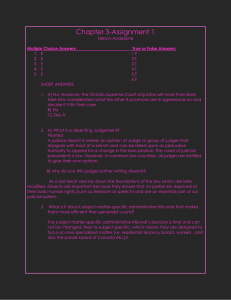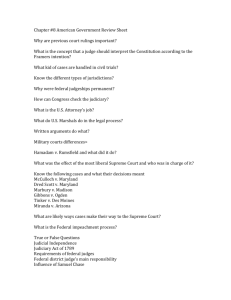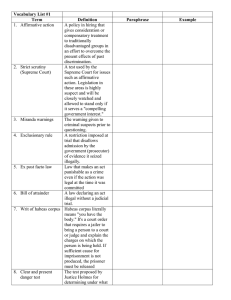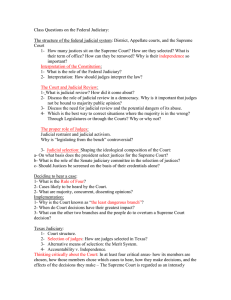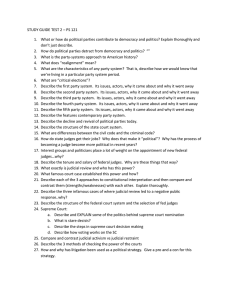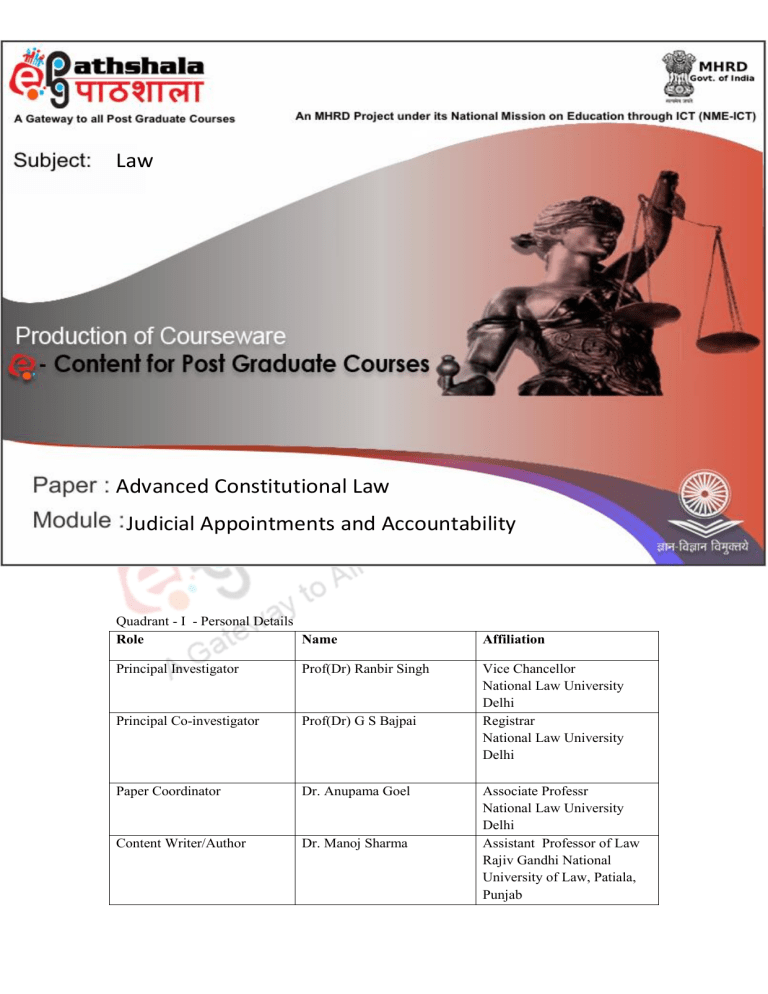
Law Advanced Constitutional Law Judicial Appointments and Accountability Quadrant - I - Personal Details Role Name Principal Investigator Prof(Dr) Ranbir Singh Principal Co-investigator Prof(Dr) G S Bajpai Paper Coordinator Dr. Anupama Goel Content Writer/Author Dr. Manoj Sharma Affiliation Vice Chancellor National Law University Delhi Registrar National Law University Delhi Associate Professr National Law University Delhi Assistant Professor of Law Rajiv Gandhi National University of Law, Patiala, Punjab Content Reviewer Prof P.S. Jaswal Vice-Chancellor, Rajiv Gandhi National University of Law, Patiala Component - I (B) Description of Module Description of Module Subject Name Law Paper Name Advanced Criminal Law Module Name/Title Judicial Appointments and Accountability Pre-requisites Understanding of the system of appointment of judges to higher judiciary under the Indian Constitution. Objectives To understand system of appointment of High Court and Supreme Court judges. To explore Judicial Accountability vis-à-vis independence of judiciary. Keywords Judicial Appointment, Independence of Judiciary Module : 32-Judicial Appointments and Accountability Structure Judicial Accountability, Introduction Position in Australia Position in United States Appointment of Judges of higher judiciary under Indian Constitution Judicial Trends Reports of Law Commission Judicial Appointments Commission Act 2014 Judicial Accountability and Judicial Independence Concluding Observations 1.0 Introduction Appointment of judges in a democratic polity, whose aim is to secure social, economic and political justice to all sections of society, is a vital task and an important aspect of judicial independence. Judicial independence is of pivotal significance in empowering and facilitating the judges to administer justice impartially and without any fear and fervor. Impartial and transparent system of judicial appointment is thus the sine qua non for ensuring judicial independence and has a direct bearing on the impartiality, integrity and independence of judges.1 Judiciary has been referred to as ‘watching tower above all the big structures of the other limbs of the state from which it keeps a watch like sentinel on the functions of other limbs’. 2 Being the cornerstone of the democracy, the presence of strong, independent, accountable and efficient judiciary is of utmost importance in achieving the Preambular objectives and constitutional goals. By and large the higher judiciary in India has performed exceedingly well during the last six decades and has by its pragmatic interpretation of the Constitution of India especially Part-III shaped the Indian polity. More or less, the higher judiciary has withstood successfully the test of times and the pressures exerted by other limbs barring a few exceptions and has not only declared various Constitutional Amendments and other Acts passed by Parliament and State Legislature as unconstitutional but has also using new interpretative tools expanded the ambit and scope of fundamental rights, drawing heavily from Part-IV and international 1 2 Shimon Shetreet, Judges on Trial (North-Holland Publishing Company, Amsterdam 1976) 46 Union of India v Sankalchand Himmatlal Sheth, AIR 1977 SC 2328 covenants. However, despite laudable role played by higher judiciary in preserving, protecting and implementing the fundamental rights of the masses, its role is not free from criticism and various doubts have been raised about the integrity of the institution. Appointment of judges of higher judiciary under executive influence and the transfer of judges by the executive has created ripples in the past on the one hand compromising judicial independence and on the other hand judicial independence has been used as shield by errant judges when various allegations of corruptions on judges of High Court and Supreme Court have been leveled. This has given impetus to the demand for rationalizing, improving, reforming and systematizing the appointment of judges of High Courts and Supreme Courts and also for bringing in transparency and accountability. 2.0 Learning Outcomes In this backdrop the system of appointment of High Court and Supreme Court judges along with attempt to rope in accountability among the higher judiciary needs to be critically examined. The objective of the paper is to apprise the reader about the mode and manner of appointment of judges to higher judiciary under the Constitution of India vis-à-vis independence of judiciary from executive interference. The aim is to analyze various decisions of Supreme Court on this issue and to analyze the reports of Law Commission of India, Report of Administrative Reform Commission (ARC) and the provisions of Judicial Appointment Commission Act, 2014. 3.0 Position in Australia In Australia the Attorney-General and the executive branch makes recommendations regarding judicial appointments to the cabinet and Governor General. The AttorneyGeneral, before the commencement of the appointment process, consults the courts and Attorney-General’s Department regarding the proposed names and then names are recommended to the Cabinet. In the appointment process, wide consultations are made including but not limited to, consultations with the Chief Justices of Family and Federal Courts, the Chief Federal Magistrate, the Australian Bar Association, Law Council of Australia etc. In addition, public notices in national and local media are also published seeking nominations and expression of interest. To assess and evaluate the candidates who have expressed their interest, an advisory panel is constituted to help the Attorney-General in recommending the names. The advisory panel submits the report to Attorney-General containing the list of names who have been considered highly suitable for appointments. The Attorney-General after considering the reports of advisory panel recommends to Governor General after approval from Prime Minister and Cabinet. 4.0 Position in United States In United States there are Federal Courts viz. Federal Magistrates, Trial Courts, Special Purpose Courts, Circuit Courts of appeal and US Supreme Court3. In addition, each state has its own set of courts viz. Justice of the peace, municipal and other local courts, State trial courts, Special purpose courts, Courts of appeal and Supreme Courts in each state.4 So far as courts in provinces are concerned, the system of appointment is through election. In some states partisan elections are held whereas in other states the elections are non-partisan. The tenure of the judges varies from state to state and is usually between 6 to 14 years. Accountability is thus ensured to the citizens since their re-appointment depends on their re-election.5 Federal judges are appointed by the President of USA with the advice and consent of the Senate. Federal Trial and Appellate judges are nominated by the President and are appointed for life. Nominations made by President are sent to Senate Judiciary Committee which holds hearings and then Judiciary Committee votes whether nominations should be sent to the Senate floor or not. The Senate thereafter votes to confirm or reject the nominations. The removal of federal judges is possible through extremely rare event of impeachment and conviction by US house of representative. Thus, the federal judges appointed for life enjoy autonomy and independence by virtue of Article 2 and 3 of US Constitution. 5.0 Appointment of Judges of Higher Judiciary under the Indian Constitution Judges of High Court are appointed under Article 217 by the President of India. Article 217(1) provides that the every judge of High Court shall be appointed by the President by warrant under his hand and seal after consultation with Chief Justice of India, the Governor of State and in the case of appointment of judges other than the Chief Justice, the Chief Justice of the High Court. The Constitution thus clearly envisages the process for the appointment of High Court judges and does not give sole authority to anyone rather the President is given the power to appoint but that power can be exercised by the President only after 3 4 5 Robert H. Alsdorf, ‘Judicial Accountability : An Elected Judge’s Perspective’ in Cyrus Das and A. Chandra (eds), Judges and Judicial Accountability (Universal Law Publishing Co. Pvt. Ltd., Delhi 2005) Ibid Tom Ginsburg, Judicial Appointments and Judicial Independence, (United States Institute for Peace, January 2009) <http://www.constitutionmaking.org/files/judicial_appointments.pdf> accessed 13 September 2014 consultation with the Chief Justice of India, the Governor and Chief Justice of the concerned High Court. Article 222 provides for transfer of High Court judges from one High court to another High Court. It provides that the President may after consultation with Chief Justice of India, transfer a judge from one High Court to another High Court. The Constitutional provision thus clearly implies that even in case of transfer of High Court judge the Chief Justice of India is required to be consulted. Constitution of India provides that (2) Every judge of the Supreme Court shall be appointed by the President by warrant under his hand and seal after consultation with such of the judges of the Supreme Court and of the High Courts in the State as the President may deem necessary for the purpose and shall hold office until he attains the age of sixty five years; Provided that in case of appointment of a Judge other than the Chief Justice, the Chief Justice of India shall always be consulted;6 The perusal of the constitutional provision enshrined in Article 124(2) reveals that in the matter of appointment of Supreme Court Judges, the President is required to consult the judges of Supreme Court and High Court as he may deem necessary. Plain reading of the above provision indicates that consultation with Chief Justice of India is a necessary requirement in case of appointment of judges of Supreme Court whereas consultation with other judges of the Supreme Court and the High Courts is to be done only when the President deems it necessary. It is pertinent to mention here that the Constituent Assembly debated whether word ‘consultation’ should be replaced by the word ‘concurrence’. Replying to the discussion, Dr. B.R. Ambdekar observed: With regard to the question of the concurrence of the Chief Justice, it seems to me that those who advocate that proposition seem to reply implicitly both on the impartiality of the Chief Justice and the soundness of his Judgment. I personally feel no doubt that the Chief Justice is a very eminent person. But after all, the Chief Justice is a man with all the failings, all the sentiments and all the prejudices which we as common people have; and I think, to allow the Chief Justice practically a veto upon the appointment of judges is really to transfer the authority to the Chief Justice which we are not prepared to 6 Constitution of India, Article 124(2) vest in the President or the Government of the day. I therefore, think that that is also a dangerous proposition.7 In the Constituent Assembly, the system prevailing in UK (where absolute authority is given to the executive to appoint judges to High Courts of Justice and Lords of Appeal) and US (where power is given to the executive but with the approval and veto by the legislature i.e. Senate) were discussed and the Constituent Assembly adopted the middle path wherein power is given to the executive but with the effective consultation with those who are well qualified to give that advise. The legislature however, avoided giving such power to a sole constitutional functionary and the word consultation was not allowed to be replaced by word concurrence. 5.1 Judicial Trends The system was followed without much controversy till emergency era when the union executive transferred sixteen High Court judges without their consent in the name of requirement for national integration. Justice Sankalchand Himmatlal Seth challenged his transfer order setting up the matter for judicial scrutiny. 8 Thereafter, the scope and ambit of consultation in appointments to higher judiciary and in transfer of High Court judges have come under judicial scanner in various landmark cases. The judicial decisions in this regard are discussed hereinafter. In Sankalchand case 9 , transfer of Justice Sankalchand from Gujrat High court to Andhra High Court was under challenge in the High Court. The full bench of High Court held that the order of transfer was invalid because there was no effective consultation between the President and Chief Justice of India. In an appeal before Supreme Court, it was held by majority that consultation with Chief Justice of India under Article 222 has to be ‘full and effective consultation’ and not a mere formality. The judgment established that Chief Justice of India’s opinion should be given primacy under Article 222. The majority ruled that transfer of High Court judges should be an exceptional measure after effective consultation with the Chief Justice of India and not as a punishment. The minority ruled that Article 222 should be interpreted to mean consensual transfer. The minority opined that word transfer used in Article 222 should be interpreted to mean as transfer with consent of the judge transferred and not without its consent in order to ensure that the executive does not impede independence of judiciary by resorting to arbitrary transfers. Thus, the attack on judicial independence through transfer of judges from one High Court to another High Court without any cogent reason and arbitrarily without full 7 8 9 Constituent Assembly Debates, Vol. 8, 258 Union of India v. Sankalchand Himmatlal Seth, AIR 1977 SC 2328 Ibid and effective consultation with Chief Justice of India and as a mean to punish the judges who do not toe the government line, fell to ground. The Apex Court ruled that Chief Justice of India’s opinion shall carry greater weight in transfer of High Court Judges. The judicial independence was, therefore defended from arbitrary executive interference. In S.P.Gupta v Union of India 10 , (First Judge’s case decided on 30/12/1981), the seven judges Bench by majority held that Article 124(2) and 217(1) speak of consultation and not concurrence and therefore it was for the Union Government to consider the opinion given by the Constitutional Functionaries and to arrive at its own decision on the appointment or non-appointment. The court concluded that while deciding, the government may override the opinion given by constitutional functionaries. Thus, the decision gave the Union Government wide discretion in matters of appointment in transfer of judges of High Court in consonance with the practices prevalent in countries like UK and Canada. The majority did not accept the concept of primacy of Chief Justice of India and opined that the proposal for appointment of High Court Judges can emanate either from Chief Justice of India or other constitutional functionaries and the opinion of all the constitutional functionaries to be consulted stands on equal footing. Thus, the judgment empowered the Union to supersede the opinion of the constitutional functionaries in matters of appointment and transfer of judges. In Supreme Court Advocates on Record Association v Union of India 11 (Second Judge’s case decided on 06/10/1993), nine judge bench of Supreme Court was constituted to reconsider the correctness of First Judge’s case judgment delivered by seven judge bench. The court by majority overruled the First Judge’s case and held that since the Chief Justice of India was best equipped to know and assess the worth of a candidate, therefore, the opinion of Chief Justice of India must carry greater weight and must be given primacy in matters of appointment of High Court and Supreme Court Judges. It was pointed out that in order to eliminate executive influence in matters of appointment of judges, it was necessary that the opinion of Chief Justice of India should prevail. However, the court ruled that the primacy of Chief Justice of India’s opinion was collective and not singular i.e. his opinion should be formed collectively after taking into account the views of two senior most Supreme Court Judges. The instant verdict of the Apex Court gave executive only a marginal function wherein executive can point out its objection to the proposal mooted by Chief Justice of India after consultation with two senior Supreme Court Judges. However, if after due consideration of the objections the same recommendation is reiterated by the Chief Justice of India, the view of Chief Justice of India shall prevail 10 11 AIR 1982 SC 149 AIR 1994 SC 268 over that that of executive. It is pertinent to mention here that as per the Second Judge’s case, the senior most Supreme Court Judge shall be normally appointed as Chief Justice of India. Thus, the Second Judge’s case established beyond doubt that in matters of appointment and transfers, the final authority lies with judiciary and not with the executive thereby substituting the term consultation with concurrence in reality. However, the degree of formality in consulting and the manner of consulting the two senior most judges of Supreme Court by the Chief Justice of India was not adequately explained in Second Judge’s case and doubts arose regarding some the recommendations made in 1998 by the then Chief Justice of India. It was alleged that the then Chief Justice of India has not adequately and effectively consulted the senior most judges as per the mandate of Second Judge’s case and accordingly presidential reference in July 1998 was made under Article 143(1). In Re-Presidential Reference 1998 (Third Judge’s case decided on 28/10/1998)12, nine judge bench was constituted to consider mainly the consultation process between Chief Justice of India and his brother judges in matters of appointment of Supreme Court and High Court Judges and in matters of transfer of High Court Judges. The majority ruled that the expression, consultation with Chief Justice of India requires consultation with the plurality of judges. Sole opinion of Chief Justice of India does not constitute consultation as contemplated in the Constitution as judicially interpreted. The court ruled that before making the recommendation for appointment of Supreme Court Judges the Chief Justice of India is required to consult four senior most puisne judges of Supreme Court. Regarding appointment of High Court Judges the consultation shall be with two senior most puisne Judges of Supreme Court. Thus, the collegium system was put in place and even if two judges of the collegiums gave an adverse opinion, no recommendation can be made. The court held that the views of other judges consulted by Chief Justice of India should be in writing and should be conveyed to government along with the recommendation. The decision has thus given the final word to the collegium rather than leaving it to the sole authority of Chief Justice of India or the President. The judgment established beyond doubt that no appointment can be made to Supreme Court and High Court unless it is in conformity with the opinion of Chief Justice of India collectively formed after consultation with collegium. 5.2 Reports of Law Commission Law Commission dealt with the subject in its various reports viz. 14th Report, 121st Report and 230th Report. In 14th Report 1958, Law Commission opined that the system of appointments is unsatisfactory and it is influenced by executive. The commission recommended that all appointments to High Court and Supreme Court 12 AIR 1999 SC 1 should be made in concurrence with the opinion of Chief Justice of India. In 121st Report, 1984, the Law Commission noticing trends in various other countries recommended the constitution of National Judicial Service Commission representing various interests. The report recommended that National Judicial Service Commission should comprise of eleven members viz. Chief Justice of India, three senior most judges of the Supreme Court, the immediate predecessor of Chief Justice of India, three senior most judges of High Court, the Attorney General of India, Minister of Law and Justice and an outstanding legal academician. The report recommended that the recommendations of National Judicial Service should be binding on the President with a rider that the President may refer the matter back to the Commission and if the Commission reiterates the same, the President should be bound by the recommendation. In 230th Report 2009, Law Commission of India pointed out that since the Chief Justice of every High Court and two senior most judges of High Court forming collegium in High Court are from outside the state as per the policy of the government, therefore the judges constituting the collegiums are not conversant with the antecedents of candidates to be appointed as judges and as such there is a likelihood of appointments being improper. Therefore, the commission suggested that the policy of transferring the Chief Justice of High Court should be given up and the post of Chief Justice of High Court should be made non-transferable. Second Administrative Reforms Commission 2007 has suggested the constitution of National Judicial Council consisting of members from all the three organs of government. It was recommended that the Council shall be headed by Vice-President and shall include the Prime Minister, the Speaker of Lok Sabha, the Chief Justice of India, the Law Minister, Leader of Opposition in Lok Sabha and Rajya Sabha. 5.3 National Judicial Appointments Commission Act, 2014 The Union legislature (Lok Sabha and Rajya Sabha) passed the National Judicial Appointments Commission Act 2014 alongwith Constitution (99th Amendment) Act contemplating a constitutional body viz. National Judicial Appointments Commission (NJAC). Under the Act passed by the Union legislature, the power to appoint High Court and Supreme Court Judges including the Chief Justices shall be vested in the NJAC. The NJAC shall consist of Chief Justice of India, two senior most judges of the Supreme Court, the Law Minister and two eminent persons to be nominated by the Committee consisting of Chief Justice of India, Prime Minister of India and Leader of Opposition. The Act provides for continuing with the precedent of appointing the senior most judge of the Supreme Court as the Chief Justice of India provided he is considered fit to hold office. 13 The power to appoint Supreme Court Judges shall vest in the Commission and the Commission shall recommend the names on the basis of ability, merit and such other criteria as may be prescribed. The Act provides that no person shall be recommended for appointment as Supreme Court Judge if any two members oppose the name.14 For appointing High Court judges other than the Chief Justice of High Court, the Commission is required to seek nominations from the Chief Justice of the concerned High Court, who shall consult two senior most judges of that High Court before nominating a person. The Commission is also empowered to nominate persons for appointment as High Court Judges. After reviewing the nominations and based on ability, merit and other criteria and after considering the views of Chief Minister and Governor of the concerned state, the NJAC shall make recommendations to the President for appointment of High Court Judges. For appointing the Chief Justice of High Court, inter se seniority of High Court judges, ability, merit and such other particulars as may be prescribed shall be the criteria. 15 The President shall appoint the judges recommended by the NJAC. It may send a name back for reconsideration but if NJAC reiterates the same name, the President shall be bound to appoint such person. The Act takes the power of appointing Judges to higher judiciary out of the ambit of collegium and seeks to ensure transparency in appointments. Constitutional (99th Amendment) Act has been ratified by the requisite number of state legislatures and has received the Presidential Assent. The Act has been notified and has been made effective from 13th April 2015. However, the actual functioning of NJAC is still a distant dream as the matter is before the Hon’ble Supreme Court. Having discussed the procedure for appointment of High Court and Supreme Court judges which is aimed at ensuring independence of judiciary, it is necessary to deal with and discuss the accountability aspect of the judges whose independence has been an outcry in all democratic countries. 6.0 Judicial Accountability and Independence of Judiciary In a democratic polity which contemplates independence of judiciary as part of basic structure of the constitution16, need for an accountability mechanism cannot be overemphasized. Accountability is sine qua non for the efficient functioning of any authority interested with responsibility17. Need for accountability in judiciary cannot 13 14 15 16 17 779 National Judicial Appointments Commission, Section 5(1) Ibid, Section 5(3) Ibid, Section 6(1) State of Bihar v. Balmukund Shah, AIR 2000 SC 1296 Shayonee Dasgupta and Sakshi Agarwal, ‘Judicial Accountability and Independence’, NUJS L. Rev. be gain-said as judiciary is bestowed with great trust reposed by the citizens who seek recourse to judicial powers to defend their democratic rights. Judicial Accountability contemplates ensuring institutional transparency and subjecting the institution for the public scrutiny so as to ensure transparent, honest and efficient system which prevents judicial delinquency for making inroads. The Constitution of India has ensured independence of judiciary by incorporating strict provisions in the Constitution of India under Articles 124 and 217 whereby judges of High Court and Supreme Court can only be removed by way of impeachment proceedings. The salaries, allowances and other benefits of High Court and Supreme Court Judges cannot be reduced after their appointment. Political and executive interference in appointments have also been thwarted to a good extent ensuring indepence of judiciary. Initiating and successfully completing impeachment proceedings for removal of judges is far too difficult making it almost improbable to remove a judge of High Court and Supreme Court. Consequently, not even a single judge has been removed by way of impeachment despite serious allegations against various judges. It has been very aptly remarked by Justice Harlan F Stone, which is true in Indian context as well, that ‘while constitutional exercise of power by the executive and legislative branches of the government is subject to judicial restraint, the only check upon our own exercise of power is our own sense of self restraint’.18 Despite the significant need for judicial accountability, the Constitution of India does not provide for any effective mechanism perhaps, due to the heartfelt need for ensuring independence of judiciary. However, in the present day scenario when the serious allegations of corruption against the sitting members of the bench have been made, it is all the more important to put in place a mechanism for ensuring Judicial Accountability and to prevent the malaise of corruption for making inroads into judicial regime. In the absence of effective constitutional checks self regulation mechanism was adopted by Apex Court in 1997 followed by ‘Restatement of Values of Judicial Life; by the Chief Justices Conference in December 1999. Thereafter Bangalore Principles of Judicial Conduct were adopted based on UN Basic Principles of Judiciary. These principles included six values viz. independence, propriety and competence, integrity, equality, impartiality and diligence. However, there is no external authority to keep restrain on judicial impropriety. Attempt to have an external agency/institution to make judiciary accountable to the masses, have met with stiff resistance. Legislature attempted to enact Judges 18 United States v. Butler 287 US 1 (1936) (Declaration of Assets and Liabilities) Bill 2009 seeking to bringing transparency but it failed in its efforts. In a significant decision, Delhi High Court in the CPIO, Supreme Court of India v Subhash Chandra Agarwal19 the Delhi High Court declared that Chief Justice of India is a public authority within the meaning of Section 2(h) of The Right to Information Act 2005 and hence was liable to provide information pertaining to asset declarations by the judges to Chief Justice of India. The court speaking through Justice S. Ravindra Bhat held that declaration of assets by the Supreme Court Judges is ‘information’ under the Right to Information Act and Chief Justice of India does not hold that information in fiduciary capacity. Interestingly Secretary General of Supreme Court preferred an appeal against single judge decision of Delhi High Court before full bench of Delhi High Court.20 While upholding the decision of single judge, the Delhi High Court opined that ‘higher the judge placed in judicial hierarchy, the greater the standard of accountability and stricter the scrutiny of accountability’. The court observed that ‘democracy expects openness and openness is concomitant of free society’. Upholding the right to access information pertaining to judges assets declarations, the court observed that ‘sunlight is the best disinfectant’. In order to have a legal mechanism for ensuring judicial standards and accountability, the Union Government introduced the Judicial Standards and Accountability Bill 2012 in Lok Sabhaa which was passed by the Lok Sabha on 29 March 2012. The Bill is pending with the Rajya Sabha. The Bill provides for constitution of an Oversight Committee21 and a Scrutiny Panel22. It lays down elaborate procedure for making of complaints against judges of High Court and Supreme Court on the ground of misbehavior or incapacity apart from making it mandatory for every judge to make a declaration of his assets and liabilities. The composition of National Judicial Oversight Committee has been proposed to include retired Chief Justice of India appointed by President, judge of Supreme Court nominated by Chief Justice of India, Chief Justice of High Court nominated by Chief Justice of India, Attorney-General of India and an eminent person nominated by President. The Bill also elaborates judicial standards to be followed by judges23. However, the law is yet to be enacted and see the light of the day. It is worth mentioning that despite serious corruption allegation against Justice V. Ramaswami, Justice P.D. Dinakaran and Justice Soumitra Sen, the impeachment proceedings could not be carried to its logical conclusions for various reasons 19 20 21 22 23 162 (2009) DLT 135 Secretary General, Supreme Court of India v Subhash Chandra Agarwal, AIR 2010 Delhi 159 Judicial Standards and Accountability Bill 2012, Section 18 Ibid, Section 10 Ibid, Section 3 including but not limited to the cumbersome impeachment procedure making it all the more important to have an effective mechanism for ensuring judicial accountability. It must be remembered that judicial independence and judicial accountability are not antithetical to each other rather they are complementary and supplementary to each other. Transparency in judiciary will surely enhance its credibility among the masses paving way for greater judicial independence. It is, therefore, submitted that an effective mechanism should be provided for ensuring greater judicial accountability and a suitable legislation should be enacted for the purpose. 7.0 Conclusions and Summary From the foregoing analysis following propositions emerge: Independence of judiciary is one of the cherished constitutional goals and has been held to be part of basic structure of the Indian Constitution. The Constitution makers emphasized the independence of judiciary by providing the consultative mechanism for appointments to higher judiciary. Judicial independence and judicial accountability are not antithetical to each other rather these are complementary to each other. Judicial accountability promotes judicial independence. The Constitution of India did not gave authority to any single constitutional functionary to appoint the High Court and Supreme Court Judges rather the power was vested in the President who was required to consult Chief Justice of India and such other judges as he may deem necessary. Consultation with Chief Justice of India has been held by the judiciary to be full and effective consultation in Sankalchand and First Judge’s case and not a mere formality. Till 1993, the ultimate power to appoint judges of High Court and Supreme Court was with the President though he was required to have full and effective consultation with Chief Justice of India and constitutional functionaries. Second Judges case and Third Judges case have titled the balance of power in appointment of judges to higher judiciary in favour of the judiciary by providing for collegium system where the Supreme court judges are appointed based on the recommendations of Chief Justice of India and four senior most puisne judges of the Supreme Court. In case of appointment of High Court judges, the appointment has to be on the recommendations of collegium consisting of CJI and two senior most judges of the Supreme Court. The role of the executive in such matters has been reduced to a mere formality. The executive can raise objections regarding the recommendations but if the same are reiterated by the collegium, the executive is bound to appoint. The NJAC Act, 2014 and 99th Constitutional (Amendment) Act have contemplated setting up of NJAC consisting of Chief Justice of India, two senior most judges of the Supreme Court, the Law Minister and two eminent persons to be nominated by the Committee consisting of Chief Justice of India, Prime Minister of India and Leader of Opposition. Under the new system to be put in place, no recommendations shall be made if any two members do not agree. The new Act has been notified from 13th April 2015. The Constitution provides for removal of errant judges on grounds of proved misbehavior and incapacity by way of impeachment but the impeachment proceedings are very cumbersome and accordingly no such judge has been removed by impeachment proceedings till date. Despite the dire need for judicial accountability, the Constitution of India has not provided for any effective mechanism for the purpose and the system of self regulation has failed to yield the desired results. Increased allegations of corruption against some of the judges of higher judiciary warrant that suitable and effective arrangements for ensuring judicial accountability should be provided.
